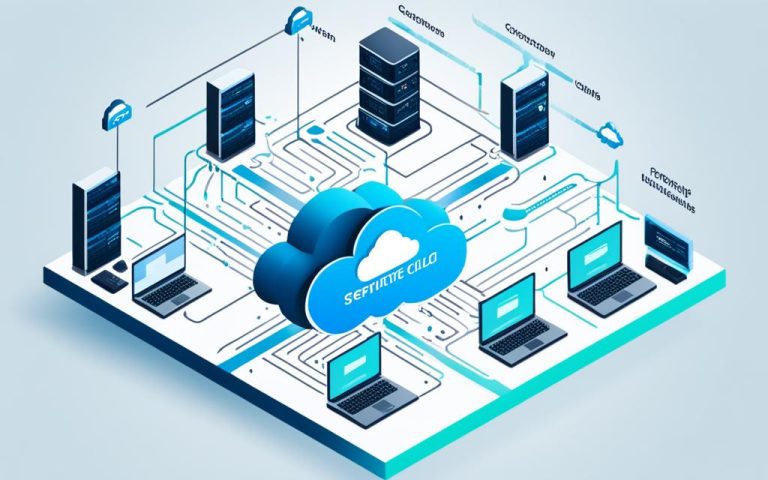Welcome to our comprehensive guide on ensuring compliance in cloud network architecture. In today’s digital landscape, cloud network compliance and cloud security compliance have become vital for businesses operating in the cloud environment. With the increasing reliance on cloud services, it is crucial for organizations to understand the shared responsibility between themselves and cloud service providers in maintaining cloud compliance.
In this guide, we will explore the importance of cloud security compliance and provide insights into how businesses can navigate the complex landscape of industry regulations and best practices. We will also delve into the various cloud compliance frameworks that can serve as valuable resources for organizations striving to achieve and maintain compliance. Let’s get started on this informative journey towards comprehensive cloud network compliance.
Understanding Cloud Security Compliance
Cloud security compliance is a vital aspect of protecting sensitive data in the cloud environment and ensuring regulatory adherence. By following a set of predefined guidelines and regulations, organizations can safeguard their data from cybersecurity threats and unauthorized access.
Implementing security measures in alignment with a security compliance framework is essential for mitigating risks associated with cloud computing. This ensures data protection, maintains data integrity, and establishes trust with customers and partners.
Cloud security compliance plays a crucial role in maintaining a secure and reliable cloud environment. By adhering to compliance standards, such as industry-specific regulations or international frameworks, organizations can effectively address cybersecurity threats and protect their sensitive information.
Why Cloud Security Compliance Matters
Ensuring cloud security compliance is of paramount importance for several reasons:
- Data Protection: Compliance measures help organizations protect their sensitive data from potential breaches and unauthorized access in the cloud.
- Cybersecurity Threats: By following cloud security compliance guidelines, organizations can mitigate the risk of cybersecurity threats, including data breaches, data loss, and unauthorized data modification.
- Regulatory Adherence: Compliance frameworks ensure that organizations meet industry-specific regulations and legal requirements, avoiding penalties and reputational damage.
- Data Integrity: Cloud security compliance ensures the integrity of data stored and processed in the cloud environment, maintaining its accuracy and reliability.
- Trust and Credibility: By prioritizing cloud security compliance, organizations build trust and credibility among their customers and partners, demonstrating their commitment to data protection and privacy.
“Cloud security compliance is not only about meeting basic security requirements; it is about protecting sensitive data and establishing a secure and ethical approach to data handling.”
By understanding and implementing cloud security compliance measures, organizations can create a robust security infrastructure, safeguard sensitive information, and meet industry standards and regulations.
Next, we will explore the shared responsibility between organizations and cloud service providers in maintaining cloud security and compliance.
What is Cloud Security Compliance?
Cloud security compliance encompasses a set of rules, regulations, and best practices that both cloud providers and organizations must adhere to ensure data security and maintain regulatory compliance within the cloud environment. These compliance standards are crucial for safeguarding sensitive data and fostering trust with customers across various industries. Different sectors, such as healthcare, finance, and government, have specific regulatory requirements that dictate the level of security necessary within their cloud infrastructure.
Cloud providers play a significant role in ensuring compliance by offering secure environments, encryption services, and continuous monitoring. By implementing robust security measures and adhering to established compliance standards, cloud providers enhance data protection and reliability for organizations utilizing their services.
It is important to note that compliance standards can vary depending on the industry and the specific regulatory bodies governing it. Common compliance standards in the cloud environment include:
- ISO/IEC 27001: This international standard specifies the requirements for establishing, implementing, maintaining, and continually improving an information security management system (ISMS) within the context of the organization’s overall business risks.
- Payment Card Industry Data Security Standard (PCI DSS): This compliance standard aims to secure payment card data and prevent fraud by establishing security controls for the processing, storing, and transmission of cardholder information.
- Health Insurance Portability and Accountability Act (HIPAA): HIPAA sets requirements for the protection of sensitive patient health information within the healthcare industry.
Compliance with these standards ensures that organizations maintain the necessary security measures to safeguard sensitive data and meet regulatory obligations, thereby minimizing the risk of data breaches and potential legal repercussions.
Cloud Provider’s Role in Ensuring Compliance
Cloud providers play a crucial role in maintaining compliance by offering secure infrastructure and services that align with regulatory requirements. They provide:
- Secure Environments: Cloud providers implement robust security controls and measures to protect infrastructure and customer data within their cloud environments.
- Encryption Services: They provide encryption services to protect data both in transit and at rest, ensuring that sensitive information remains confidential even if it is compromised.
- Continuous Monitoring: Cloud providers perform regular security assessments and monitoring to identify and address any vulnerabilities or compliance gaps.
By partnering with trusted and compliant cloud providers, organizations can leverage the expertise and resources necessary to meet their regulatory obligations and enhance data security.
To illustrate the effectiveness of cloud security compliance, here’s an example of a well-known cloud provider’s compliance standards:
| Cloud Provider | Compliance Standards |
|---|---|
| Amazon Web Services (AWS) |
|
By complying with these standards, AWS ensures the security and compliance of their cloud services, which builds trust and confidence among organizations relying on their infrastructure.
Overall, cloud security compliance plays an integral role in maintaining data security, meeting regulatory standards, and fostering trust between organizations and cloud providers. Organizations must prioritize compliance to protect sensitive data, mitigate risks, and establish a secure cloud environment.
Importance of Cloud Compliance
The importance of cloud compliance cannot be overstated, as it plays a vital role in ensuring data security, meeting regulatory standards, and building trust and credibility between organizations and cloud providers. Cloud compliance goes beyond basic security requirements and encompasses a comprehensive approach to protecting sensitive data from potential breaches and cyber threats that could have grave consequences for businesses.
By adhering to industry-specific regulatory standards such as HIPAA (Health Insurance Portability and Accountability Act), GDPR (General Data Protection Regulation), or PCI DSS (Payment Card Industry Data Security Standard), cloud providers create a secure environment that safeguards their clients’ information and instills confidence in their ability to handle data responsibly.
Compliance acts as a foundation for maintaining a transparent and ethical approach to data handling, which is crucial in the ever-evolving landscape of cybersecurity risks. Organizations that prioritize cloud compliance demonstrate their commitment to protecting customer data and ensuring the privacy and security of sensitive information.
Ensuring cloud compliance builds trust and credibility by showcasing a strong commitment to protecting data, adhering to regulatory standards, and implementing robust security measures. This trust is not only crucial for maintaining existing customer relationships but also for attracting new customers and partners in an increasingly competitive digital marketplace.
Cloud compliance provides several benefits:
- Enhanced Data Security: Compliance regulations help organizations implement robust security measures, encryption protocols, and access controls to protect data from unauthorized access or breaches.
- Improved Regulatory Compliance: By adhering to industry-specific standards and regulations, such as HIPAA or GDPR, organizations ensure that they meet legal obligations and reduce the risk of penalties or legal consequences.
- Minimized Business Risks: Compliance protocols mitigate potential risks and vulnerabilities by establishing a framework that addresses cybersecurity threats and fosters a culture of proactive risk management.
- Strengthened Trust and Credibility: Compliance demonstrates commitment to data protection and privacy, establishing trust with customers, partners, and stakeholders who entrust their sensitive information to cloud service providers.
Ultimately, cloud compliance is not just about meeting regulatory requirements but also about instilling trust and credibility in the digital landscape. Organizations that prioritize cloud compliance are better equipped to protect data, mitigate risks, and maintain a competitive edge in an increasingly security-conscious environment.

| Benefits of Cloud Compliance | Description |
|---|---|
| Enhanced Data Security | Implementation of robust security measures, encryption protocols, and access controls to protect data from unauthorized access or breaches. |
| Improved Regulatory Compliance | Adherence to industry-specific standards and regulations, such as HIPAA or GDPR, ensuring legal obligations are met and reducing the risk of penalties or legal consequences. |
| Minimized Business Risks | Establishment of a framework that addresses cybersecurity threats and fosters proactive risk management, mitigating potential risks and vulnerabilities. |
| Strengthened Trust and Credibility | Demonstration of commitment to data protection and privacy, establishing trust with customers, partners, and stakeholders. |
Shared Responsibility of Cloud Security and Compliance
The shared responsibility of cloud security and compliance involves a collaborative effort between organizations and Cloud Service Providers (CSPs) to protect data and uphold regulatory standards. Organizations are responsible for securing their own data and applications hosted in the cloud, implementing proper access controls, encryption, and monitoring mechanisms.
CSPs, on the other hand, are tasked with ensuring the security of the cloud infrastructure, maintaining compliance certifications, and delivering secure services to their customers. This division of responsibilities requires clear communication, mutual understanding, and adherence to established protocols to create a robust security framework.
“The collaboration between organizations and CSPs is crucial in maintaining the security and compliance of cloud services. By working together, organizations can benefit from the expertise and infrastructure provided by CSPs, while also fulfilling their own obligations to protect sensitive data.” – John Smith, Cloud Security Expert
Organizations need to understand their specific responsibilities in the cloud environment. This includes implementing security controls, conducting regular audits, and training employees to follow best practices. By actively participating in the shared responsibility model, organizations can play a vital role in mitigating risks and ensuring the overall security and compliance of their cloud infrastructure.
Benefits of Shared Responsibility:
- Increased accountability for data security
- Efficient utilization of resources
- Reduced burden on organizations
- Access to specialized expertise and resources
- Improved regulatory compliance
The shared responsibility model strengthens the overall security posture of organizations by combining their efforts with the security measures provided by CSPs. This collaboration establishes a layered defense approach, where both parties contribute to creating a secure and compliant cloud environment.
The image above illustrates the interdependence and collective effort required to maintain cloud security and compliance. Organizations and CSPs must work together to protect data, uphold regulatory standards, and safeguard the integrity of their cloud infrastructure.
Cloud Compliance Frameworks
Cloud Compliance Frameworks play a crucial role in guiding organizations to achieve and maintain cloud security compliance. These frameworks provide a set of guidelines and controls that organizations can leverage to ensure the implementation of effective security measures in their cloud environments. Let’s take a closer look at some of the prominent cloud compliance frameworks:
1. Cloud Security Alliance (CSA) Controls Matrix
The Cloud Security Alliance (CSA) Controls Matrix offers a comprehensive set of best practices and guidelines specifically designed to secure cloud environments. It encompasses various domains such as governance, risk management, compliance, and data protection, enabling organizations to assess their compliance posture effectively.
2. Federal Risk and Authorization Management Program (FedRAMP)
The Federal Risk and Authorization Management Program (FedRAMP) is a government-wide program that standardizes the security assessment, authorization, and continuous monitoring of cloud products and services. FedRAMP compliance provides organizations with a framework to ensure the security and integrity of their cloud-based systems while meeting federal regulations.
3. National Institute of Standards and Technology (NIST)
The National Institute of Standards and Technology (NIST) framework focuses on promoting cybersecurity standards and best practices for federal information systems. It provides a comprehensive set of guidelines that organizations can use to establish a strong foundation for cloud security compliance. The NIST framework emphasizes risk assessment, security controls, and continuous monitoring to mitigate cybersecurity threats effectively.
4. International Organization for Standardization (ISO)
The International Organization for Standardization (ISO) offers internationally recognized standards for information security management, including cloud security compliance. Organizations can leverage ISO certifications to demonstrate their commitment to maintaining the highest levels of security and compliance in the cloud environment.
These cloud compliance frameworks provide organizations with a structured approach to assess, implement, and maintain effective security controls in their cloud environments. By aligning with these frameworks, organizations can enhance their ability to meet regulatory requirements, protect sensitive data, and build trust with their stakeholders.
Conclusion
In today’s digital landscape, ensuring compliance in cloud network architecture is of utmost importance for businesses. Understanding cloud security compliance, the shared responsibility between organizations and cloud service providers, and utilizing cloud compliance frameworks are essential for establishing a robust security infrastructure. By prioritizing cloud network compliance and adopting best practices, businesses can protect sensitive data, build trust with customers, and ensure long-term success.
Maintaining compliance requires regular audits, effective access control measures, encryption protocols, and continuous monitoring. These practices help organizations stay updated with changes in the cloud environment and meet industry standards and regulations. By leveraging technology and staying vigilant, businesses can proactively address potential security risks and strengthen their defense against evolving threats.
With cloud network compliance in place, organizations can demonstrate their commitment to data security and regulatory compliance. Such compliance not only safeguards valuable information but also establishes credibility and trust in the market. By investing in cloud security compliance and adhering to best practices, businesses can confidently navigate the digital landscape and enjoy the benefits of the cloud while maintaining the integrity of their data.
FAQ
What is cloud security compliance?
Cloud security compliance refers to the process of following a set of predefined guidelines and regulations to ensure that data stored in the cloud is protected from cybersecurity threats and unauthorized access.
Why is cloud security compliance important?
Cloud security compliance is important for ensuring the security of data, meeting regulatory standards, and fostering trust between organizations and cloud providers.
What is the shared responsibility of cloud security and compliance?
The shared responsibility of cloud security and compliance involves a collaborative effort between organizations and Cloud Service Providers (CSPs) to protect data and uphold regulatory standards.
What are some cloud compliance frameworks?
Some cloud compliance frameworks include the Cloud Security Alliance (CSA), the Federal Risk and Authorization Management Program (FedRAMP), the National Institute of Standards and Technology (NIST) framework, and the International Organization for Standardization (ISO).



















